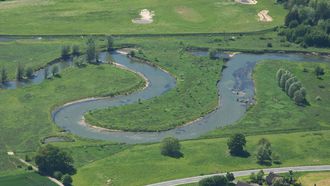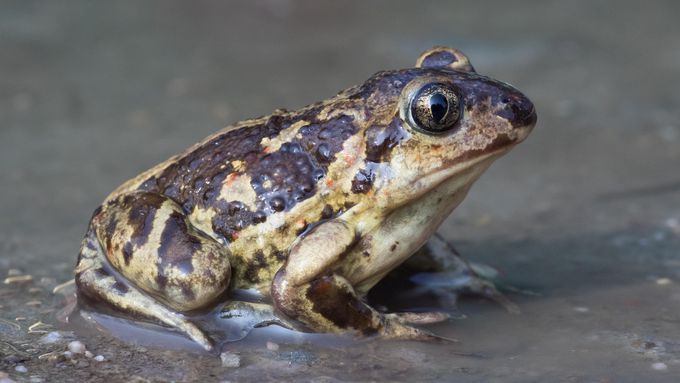Aerial image of the site „Sandacker“ in Lippstadt-Eickelborn, with the newly created waterbodies and terrestrial habitat at the top. © Luise Hauswirth
download picturemain content
Project of the month
#8/2018 LIPPE FLOODPLAIN NEAR LIPPSTADT
Support and Development of Habitats for the Common Spadefoot
As part of the Integrated LIFE Project "Atlantic Region DE", first actions for the common spadefoot began in autumn 2017 in the Lippe floodplain west of Lippstadt. In the immediate vicinity of the natural spawning grounds of the species in the area "Rote Beeke" as well as on the edge of the terrace of the Lippe floodplain near Lippstadt-Eickelborn, new ponds and land habitats were created. The implementation was carried out by the district government of Münster in cooperation with the Working Group for Biological Environmental Protection in the county of Soest (ABU) and the Lower Nature Conservation Authority of the county of Soest.
The common spadefoot is strictly protected throughout Europe as a species listed in Annex IV of the Habitats Directive. As a burrowing sand specialist originating from the eastern steppe regions, it relies on frost-protected and flood-free habitats with loose soil. During the day and over the cold season, it buries itself into the ground, in frost more than a metre deep. For this purpose, this Amphibian species, like all members of the family of the European spadefoot toads (Pelobatidae) uses its remarkably powerful hind legs with digging calluses. In addition, for reproduction the common spadefoot needs long-standing water-bearing waterbodies near to their terrestrial habitat. However, these have become very rare and are threatened by large-scale nutrient inputs and levelling in northwestern Germany.
In the county of Soest, sandy soils are rare by nature. Narrow edges of the terrace along the river Lippe and the southwestern arms of the Senne with its sandy soils extend into the county as far as Lippstadt. However, there hardly remain any suitable spawning waters for the common spadefoot in the floodplain of the Lippe.
In the area "Rote Beeke", dedicated volunteers have undertaken proof checks of the common spadefoot since 2013. Amphibian fences were set up and inspected voluntarily for four years each morning in March and April. Some of the adult toads found there were transferred to the breeding station in Enniger (county of Warendorf), operated by the NABU Nature Conservation Station Münsterland, where the females were able to attach their egg strings to spawning structures under optimal conditions and the tadpoles could develop free from predators. Later in the year, the adult common spadefoots as well as the reared tadpoles were brought back into the waterbodies of origin at the outskirts of Lippstadt. In addition, the parks and gardens department of the City of Lippstadt cut back the shrubs at the ponds in order to create suitable conditions for the reproduction of the common spadefoot, i.e. older, more or less densely covered and sunlit waterbodies. With the creation of three waterbodies which carry water all-season at close range to the proven occurrence of the common spadefoot, the LIFE IP has established stepping stone biotopes to support and expand the population.
The second site in the Lippe floodplain near Lippstadt-Eickelborn, a former sandy field in the Schoneberger Heide, had been acquired by the state of North Rhine-Westphalia in 2013 as part of the Lippe floodplain renaturation in connection with the EU Water Framework Directive. Subsequently, it was converted into an extensive grassland area. The site is approximately nine kilometres away from the known population of the common spadefoot at “Rote Beeke” in Lippstadt. Within the framework of the LIFE IP two new waterbodies as spawning waters as well as terrestrial habitat for the species were created to allow for the establishment of the species. At both sites, tadpoles and / or young toads from the breeding station of the NABU Nature Conservation Station Münsterland will be released in 2018 and 2019.
Other protected species such as the crested newt and the European tree frog will also benefit from the creation of the new waterbodies. Via monitoring within the LIFE IP, the success of the common spadefoot releases will be reviewed.
Related Topics
additional information
Further Links
- Natura 2000 Gebiet „Teilabschnitte Lippe- Unna, Hamm, Soest, Warendorf“ – Landesamt für Natur und Umweltschutz (in German) (external link opens in a new window)
- Naturschutzgebiet „Lippeaue“ – Landesamt für Natur und Umweltschutz (in German) (external link opens in a new window)
- usflugsziele im Gebiet – Natur erleben NRW (in German) (external link opens in a new window)
- Arbeitsgemeinschaft Biologischer Umweltschutz im Kreis Soest e. V. + Biologische Station Soest (in German) (external link opens in a new window)





